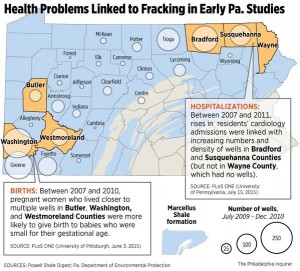U. Penn & Pitt studies link fracking with health problems
From an Article by Don Sapatkin, Philadelphia Inquirer, July 15, 2015
Research released Wednesday from the University of Pennsylvania found that as more wells were drilled in Northeastern Pennsylvania, hospital admission rates for cardiovascular events rose in the same areas.
A study last month from the University of Pittsburgh linked how far women live from wells in southwestern Pennsylvania with the incidence of babies born small for their gestational age. And research out of Colorado in December found an association between living closer to natural gas development and having a child with a congenital heart defect.
The studies only show links, not cause and effect, and are not based on direct calculations of exposure to contaminants. Nevertheless, they are among the first peer-reviewed studies of the potential health effects of a controversial gas extraction process that Pennsylvania has embraced.
A statewide registry to track health problems was recommended by an advisory commission in 2011 and included in legislation the following year. But the funding was stripped out. Scientists have sought other ways to look at possible health risks.
The Penn study, published in the journal PLoS ONE, analyzed hospital discharge data for 93,000 inpatients, by zip code, between 2007 and 2011 in three counties in Pennsylvania’s northeastern corner. Bradford and Susquehanna each had large increases over that time in wells that use the technique known as hydrofracturing, or fracking, to extract deposits of natural gas. Neighboring Wayne County had no gas development.
While hospital admission rates decreased slightly or remained constant overall, as they have nationwide, hospitalizations for cardiology were about 27 percent higher over five years among residents who lived in zip codes with more wells and more wells per square kilometer than among those whose zip codes had the least.
Neurology admissions also increased significantly for zips with more wells.
Senior author Reynold A. Panettieri Jr., a professor of pulmonary medicine at the University of Pennsylvania, speculated that more air pollution and higher environmental stress could have caused the cardiology increases. “Our guess is that the numbers of big trucks,” he said, caused a “tremendous increase in diesel exhaust fumes as well as ozone.” Noise may have disrupted sleep, leading to rising cases of hypertension and heart disease, Panettieri said.
Panettieri said that he had expected the analysis to find an increase in pulmonary admissions – it did not – but that stress actually has a greater effect on heart conditions among adults.
Panettieri’s team is gathering similar data on outpatient and emergency room visits. The study was funded by the National Institute of Environmental Health Sciences.
Besides a dearth of baseline data, the long time needed for many medical conditions to develop makes research findings difficult. Geological conditions also vary widely, so a study conducted in southwestern Pennsylvania, where the gas has higher levels of benzene, may not apply to the northeast.
University of Pittsburgh Study
The study of three southwestern Pennsylvania counties published last month used both the distance between a mother’s residence and gas wells and the density of nearby wells as a substitute for an actual measure of exposure to well pollutants.
Of the 15,451 babies born between 2007 and 2010 within 10 miles of a well in Butler, Washington, and Westmoreland Counties, those whose mothers had the highest “exposures” were 34 percent more likely to be small for their gestational age than those with the least exposures. Size for gestational age is known to be related to later health problems.
Bruce Pitt, a coauthor of that study and a professor of environmental and occupational health at the University of Pittsburgh Graduate School of Public Health, said the three recent studies were not enough to change policy. But he noted that even earlier evidence was sufficient for Maryland and New York to ban fracking.
“As studies start accumulating, we get a preponderance of evidence,” said Lisa McKenzie, an assistant research professor at the Colorado School of Public Health and lead author of the December study looking at congenital heart defects and well development in rural Colorado.
“The more studies being done that show that there might be some health effects, the more likely it is that there might be some health effects associated with this,” McKenzie said.
See also: www.FrackCheckWV.net


{ 1 comment… read it below or add one }
The elephant is in the room and no one seems to notice. The Black shales were found by the US Dept. of the interior. They are dried sea beds. A uranium find. It has radioactive brine and when it rots gives off radon gasses.
Radioactive Drill cuttings and the brine along with the toxic chemicals all contribute to a poisoned environment. It is being dumped into our air through flaring. Into our drinking water by dumping into streams and washing off of roads.
Yet the government knows about the study and has hidden it from site. The media also is complacent in this crime !